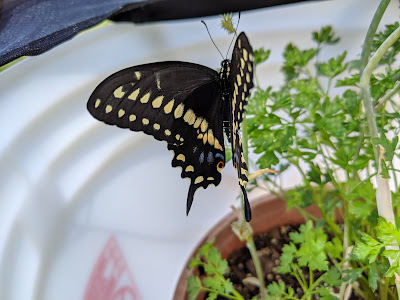A Tail of Two Caterpillars
Picking up
where we left off, the two caterpillars had been given a large potted plant to feed on, set in my honey-straining bucket. I showed you the first chrysalis, attached to some fennel.
 |
| The bottom half of my butterfly habitat. 7/25/19 |
One thing I forgot to mention is the size change from caterpillar to chrysalis. It shocked me. Here's a photo of the two caterpillars so you can see how much smaller the girdled, ready-to-pupate caterpillar is compared to the caterpillar that is still actively feeding.
 |
| Not a matter of depth perception. The inverted-J caterpillar is much smaller than its sibling. 7/27/19 |
After head-butting its girdled sibling, causing it to jerk defensively, the second caterpillar ate a bunch, purged a blob of semi-digested parsley, then went for its walkabout. It left the potted plant and went up into the hamper, where I'd placed several long flower stalks for them to choose from.
 |
| Second caterpillar girdled to a day lily flower stalk. 7/28/19 |
It too formed its chrysalis during the middle of the night so, again, I didn't get any pictures of it happening.
 |
| The second chrysalis. 7/29/19 |
There's quite a bit of detail and texture, so be sure to click/tap on the photo and zoom in. Once they go into chrysalis, the waiting game starts. I read that
they emerge in 9-11 days but anecdotally I heard as short as a week. I'm sure that day/night temps and day length play a role, so I figured mine being indoors would emerge on the later end of the spectrum. Of course, that didn't stop me from checking incessantly.
Caterpillar 1
Pretty much nothing happened until a day or two before the butterfly emerged. True to itself, the first caterpillar to pupate was the first to show a subtle change. Without my macro lens, I might've thought the slight darkening was just lighting conditions, a shadow cast on it.
 |
| 11 days as a chrysalis. The top side is grayish-green instead of bright green. |
Early in the morning of day 12, I found the butterfly emerged and flexing its flight muscles. Its wings were already dry and fully expanded. Having seen its plain Jane, black and yellow
mother, I was really happy to see all this color. The neighborhood females should find him quite attractive.
 |
| The caterpillar, I mean, butterfly pooped on the fennel stalk. The meconium ran down to the girdle. |
I had to wait for what seemed like forever to see the top view, where you can determine the sex of the butterfly. From the dorsal view, males have more yellow than blue, and females have more blue than yellow.
 |
| I find it fascinating that the underside of the wing looks entirely different from the topside. It's so thin, how can that be? |
It might've been because I was sticking a phone in his face, but he took a misstep and fell between the potted plant and bucket. He couldn't climb up the plastic, so I stuck my hand in and he walked right onto it.
 |
33 days from egg to butterfly. This is a male. Females have more blue and a smaller yellow upper band.
|
As newly-emerged mason bees often do (or don't?), butterflies don't walk onto the flower you show it. They tease you by touching it, then
zip-bang they're into the wind. I barely got to see him fly, he flew away so fast. I hope he imprinted on my garden and comes back.
Caterpillar 2
Day 17 and I am starting to wonder if it's a dud but hoping it's just going to overwinter as a chrysalis. Be sure to
add my blog to your feedburner (I use Feedly) so you don't miss a post about it emerging in, oh I don't know, April?
 |
| The second chrysalis showing no signs of change. 8/14/19 |









2 comments:
What a fun thing to watch! I'll have to plan a little better for my dill forest next year and bring any eggs/hatchlings inside before the wasps get them.
I'm seeing a lot of young Ambush Bugs @Don, some on my parsley. They are quite adept at snatching bees and certainly would have no trouble catching and eating caterpillars.
Post a Comment
Join the Conversation. Leave a comment.